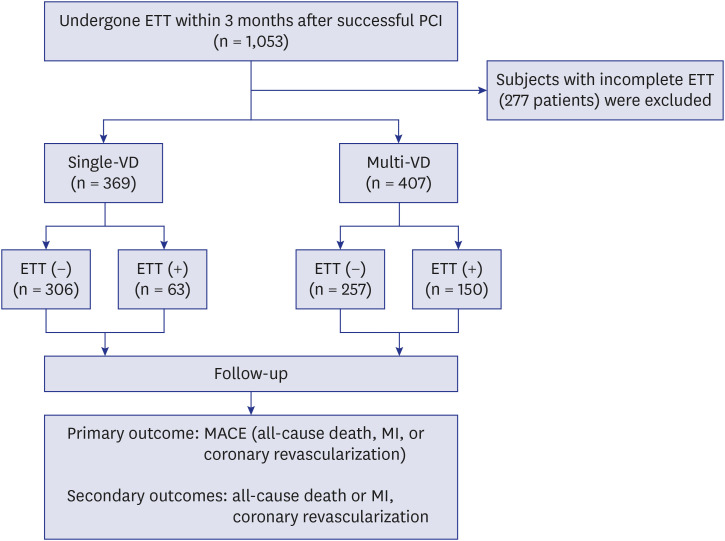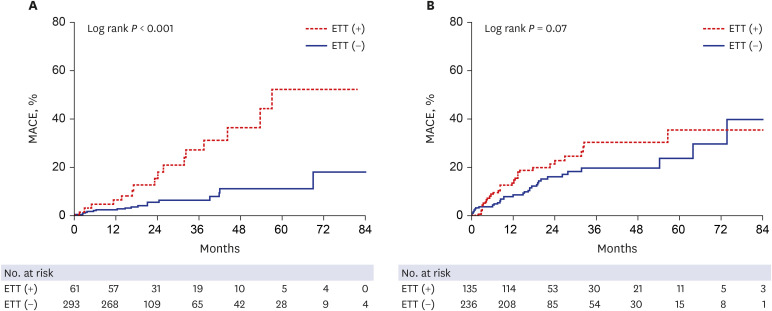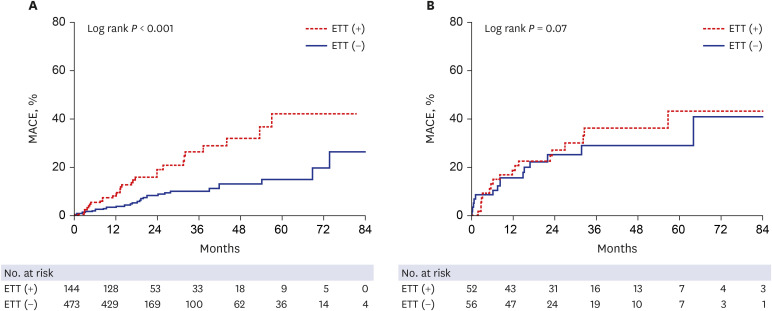J Korean Med Sci.
2020 Jul;35(27):e229. 10.3346/jkms.2020.35.e229.
Clinical Implications of Early Exercise Treadmill Testing after Percutaneous Coronary Intervention in the Drug-eluting Stent Era
- Affiliations
-
- 1Division of Cardiology, Department of Internal Medicine, Inje University Ilsan Paik Hospital, Inje University College of Medicine, Goyang, Korea
- 2Division of Cardiology, Department of Medicine, Heart Vascular Stroke Institute, Samsung Medical Center, Sungkyunkwan University School of Medicine, Seoul, Korea
- KMID: 2504264
- DOI: http://doi.org/10.3346/jkms.2020.35.e229
Abstract
- Background
Limited data are available on the clinical meaning of early routine exercise treadmill testing (ETT) after percutaneous coronary intervention (PCI) in the drug-eluting stent era. We aimed to determine the clinical utility and implications of early routine ETT after PCI.
Methods
This was a single-center, prospective cohort study. A total of 776 patients underwent ETT within 3 months after index PCI were analyzed. We classified patients into ETT positive (+) and negative (−) groups and compared major adverse cardiac events (MACE) including all-cause death, myocardial infarction, and coronary revascularization.
Results
The median follow-up duration was 19.6 months (interquartile range, 15.4 to 33.5 months). ETT was positive for 63 patients (17.1%) with single-vessel disease (VD) and 150 patients (36.9%) with multi-VD. Previous PCI, absence of thrombotic lesion, multi-VD, and residual Synergy Between PCI With Taxus and Cardiac Surgery (SYNTAX) score > 8 were independent predictors of ETT (+). Compared with the ETT (−) group, the ETT (+) group was associated with increased risk of MACE for patients with single-VD (18.1% vs. 52.3%; adjusted hazard ratio [HR], 2.67; 95% confidence interval [CI], 1.10–6.49; P = 0.03) and residual SYNTAX score ≤ 8 (26.5% vs. 42.1%; adjusted HR, 1.90; 95% CI, 1.09–3.30; P = 0.02), but not for patients with multi-VD and residual SYNTAX score > 8.
Conclusion
Early routine ETT after PCI might be helpful for predicting clinical outcomes in patients with single-VD and residual SYNTAX score ≤ 8 but not multi-VD and residual SYNTAX score > 8.
Figure
Reference
-
1. Gibbons RJ, Balady GJ, Bricker JT, Chaitman BR, Fletcher GF, Froelicher VF, et al. ACC/AHA 2002 guideline update for exercise testing: summary article. A report of the American College of Cardiology/American Heart Association Task Force on Practice Guidelines (Committee to Update the 1997 Exercise Testing Guidelines). J Am Coll Cardiol. 2002; 40(8):1531–1540. PMID: 12392846.2. Levine GN, Bates ER, Blankenship JC, Bailey SR, Bittl JA, Cercek B, et al. 2011 ACCF/AHA/SCAI Guideline for Percutaneous Coronary Intervention: a report of the American College of Cardiology Foundation/American Heart Association Task Force on Practice Guidelines and the Society for Cardiovascular Angiography and Interventions. Circulation. 2011; 124(23):e574–e651. PMID: 22064601.3. Wolk MJ, Bailey SR, Doherty JU, Douglas PS, Hendel RC, Kramer CM, et al. ACCF/AHA/ASE/ASNC/HFSA/HRS/SCAI/SCCT/SCMR/STS 2013 multimodality appropriate use criteria for the detection and risk assessment of stable ischemic heart disease: a report of the American College of Cardiology Foundation Appropriate Use Criteria Task Force, American Heart Association, American Society of Echocardiography, American Society of Nuclear Cardiology, Heart Failure Society of America, Heart Rhythm Society, Society for Cardiovascular Angiography and Interventions, Society of Cardiovascular Computed Tomography, Society for Cardiovascular Magnetic Resonance, and Society of Thoracic Surgeons. J Am Coll Cardiol. 2014; 63(4):380–406. PMID: 24355759.4. Eisenberg MJ, Schechter D, Lefkovits J, Goudreau E, Deligonul U, Mak KH, et al. Utility of routine functional testing after percutaneous transluminal coronary angioplasty: results from the ROSETTA registry. J Invasive Cardiol. 2004; 16(6):318–322. PMID: 15156002.5. Babapulle MN, Diodati JG, Blankenship JC, Huynh T, Cugno S, Puri R, et al. Utility of routine exercise treadmill testing early after percutaneous coronary intervention. BMC Cardiovasc Disord. 2007; 7(1):12. PMID: 17394661.
Article6. Eisenberg MJ, Wilson B, Lauzon C, Huynh T, Eisenhauer M, Mak KH, et al. Routine functional testing after percutaneous coronary intervention: results of the aggressive diagnosis of restenosis in high-risk patients (ADORE II) trial. Acta Cardiol. 2007; 62(2):143–150. PMID: 17536602.7. Georgoulias P, Demakopoulos N, Tzavara C, Giannakou S, Valotassiou V, Tsougos I, et al. Long-term prognostic value of Tc-99m tetrofosmin myocardial gated-SPECT imaging in asymptomatic patients after percutaneous coronary intervention. Clin Nucl Med. 2008; 33(11):743–747. PMID: 18936603.
Article8. Acampa W, Petretta M, Florimonte L, Mattera A, Cuocolo A. Prognostic value of exercise cardiac tomography performed late after percutaneous coronary intervention in symptomatic and symptom-free patients. Am J Cardiol. 2003; 91(3):259–263. PMID: 12565079.
Article9. Georgoulias P, Tzavara C, Demakopoulos N, Giannakou S, Valotassiou V, Tsougos I, et al. Incremental prognostic value of (99m)Tc-tetrofosmin myocardial SPECT after percutaneous coronary intervention. Ann Nucl Med. 2008; 22(10):899–909. PMID: 19142709.
Article10. de la Morena G, Sanchez-Muñoz JJ, Lopez Candel J, Pico-Aracil F, Ruiperez JA. Early and late exercise testing. Usefulness after percutaneous transluminal coronary angioplasty. Chest. 1993; 103(2):391–395. PMID: 8432125.11. Capodanno D, Tamburino C. Integrating the Synergy between percutaneous coronary intervention with Taxus and Cardiac Surgery (SYNTAX) score into practice: use, pitfalls, and new directions. Am Heart J. 2011; 161(3):462–470. PMID: 21392599.
Article12. Malkin CJ, George V, Ghobrial MS, Krishnan A, Siotia A, Raina T, et al. Residual SYNTAX score after PCI for triple vessel coronary artery disease: quantifying the adverse effect of incomplete revascularisation. EuroIntervention. 2013; 8(11):1286–1295. PMID: 23538157.
Article13. Fletcher GF, Balady GJ, Amsterdam EA, Chaitman B, Eckel R, Fleg J, et al. Exercise standards for testing and training: a statement for healthcare professionals from the American Heart Association. Circulation. 2001; 104(14):1694–1740. PMID: 11581152.14. Thygesen K, Alpert JS, Jaffe AS, Simoons ML, Chaitman BR, White HD, et al. Third universal definition of myocardial infarction. Eur Heart J. 2012; 33(20):2551–2567. PMID: 22922414.
Article15. Goldman LE, Okrainec K, Eisenberg MJ, Schechter D, Lefkovits J, Goudreau E, et al. Six-month outcomes after single- and multi-lesion percutaneous coronary intervention: results from the ROSETTA registry. Can J Cardiol. 2004; 20(6):608–612. PMID: 15152290.16. Farooq V, Serruys PW, Bourantas CV, Zhang Y, Muramatsu T, Feldman T, et al. Quantification of incomplete revascularization and its association with five-year mortality in the synergy between percutaneous coronary intervention with taxus and cardiac surgery (SYNTAX) trial validation of the residual SYNTAX score. Circulation. 2013; 128(2):141–151. PMID: 23766350.
Article
- Full Text Links
- Actions
-
Cited
- CITED
-
- Close
- Share
- Similar articles
-
- Terrible Stent Thrombosis Induced by a Treadmill Test Performed Three Days after Percutaneous Coronary Intervention
- Diffuse Long Coronary Artery Disease is Still an Obstacle for Percutaneous Coronary Intervention in the Second-Generation Drug-Eluting Stent Era?
- Drug-Eluting Stent: Present and Future
- Novel Coronary Stent Platforms
- Two Cases of Immediate Stent Fracture after Zotarolimus-Eluting Stent Implantation




